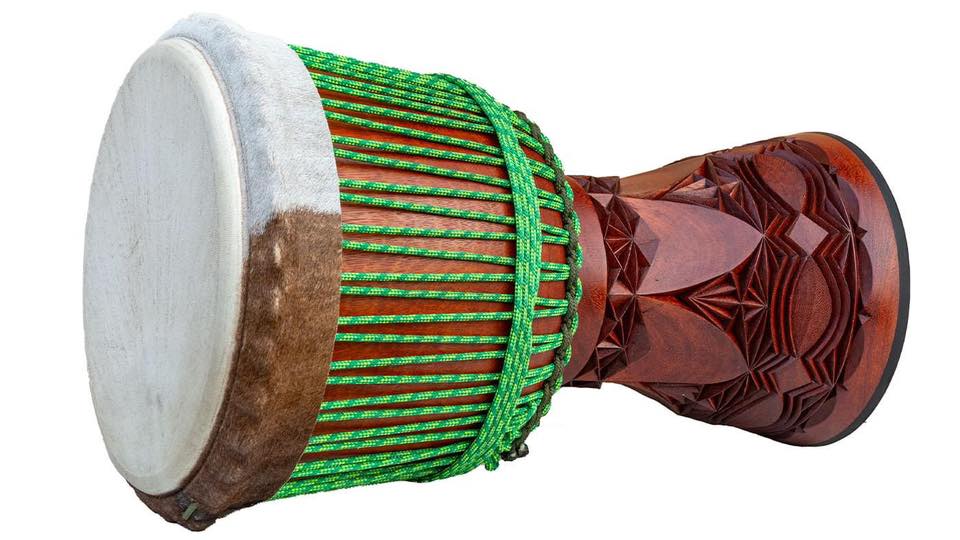I am often asked, “what is the best djembe”? And, “which drum should I buy”. If you are in the market for a djembe drum you are faced with a huge variety of choices. There are djembes made in West Africa, Bali, Thailand, India and many different parts of the world.
The internet has hundreds of ads for seemingly nice and even inexpensive drums.
The first thing we need to realize is that a djembe drum, is a musical instrument like any other instrument. Like a guitar, violin or any other piece of gear tha tis made from a craftsman. It is not a toy, and on a professional level it has had careful design, forethought and expert execution in its develpemet from a log to a finely tuned musical piece.
So what is the best djembe for you, for your needs and where do you get it?
Which djembe drum should you buy? Most of the time I recommend a professional level djembe. It does not have to be the super high end top of the line, but a “Pro” model.
Why? Because they are made with the highest quality materials that will last the longest, they are generally made with more care and the sound is going to be better. The skins are going to be better and probably last longer as well.
Obviously you want to look for a djembe drum that is made very well. What does this mean?
It means that is was made with the intention of being played as a musical instrument and not a toy. There has been time and care put into the carving. The wood quality is high, the wood was properly cared for and aged.
if you are examining it in person, check to see that it is balanced, one side of the skin is not higher or lower then the other side. Also you do not want the skin pulled too low over the side. Look for cracks. You want uniformity.
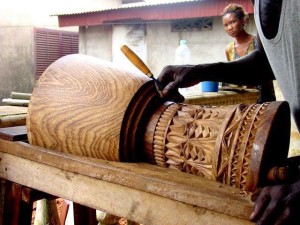
The Art Of Djembe
www.wuladrum.com
Many new drums have cracks! Some cracks are superficial and some can become problematic down the line. You also want good strong quality rope and a quality skins.
A crack repair does not mean that you will have a problem with the drum ever and as amateur of fact you can often get a substantial discount from ordering a drum from a reliable source that has done a proper repair.
I have several personal drums that i have bought either with cracks or that I have had repairs done to and none of them have ever given me any problems in the last 30 years! But, it depends on who repairs or repaired the drum. Knowledge is the key strategy here.
Remember this. “The misery of a low quality, cheap item will last a lot longer then the initial pain of an expensive high quality one”. It might seem like a great buy or maybe it is all you can afford. But when your drumming improves later on and you try to sell this drum it is going to be very difficult to sell a cheaply made drum.
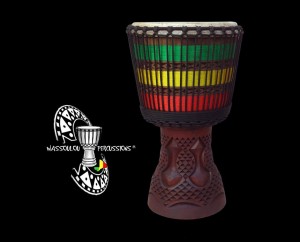
Therefore, I strongly suggest you get the best possible drum you can afford and please do not buy it on eBay.
Save your dollars and invest in a quality instrument.
Why, because you get what you pay for. And right now there are great opportunities to buy some really interesting beautiful and great sounding drums from some really good companies that care about their products and even more so that their buyers are happy.
The companies I have listed below have good , solid reputations and really great products. You don’t have to worry about if you are getting the real deal or not. There are so many fakes on line and craiglist. And on ebay, forget it! Everyone say’s they have a professional djembe there. They are not! Unless it is a used model from one of the companies I have listed.
The problem with any used djembe is you do not know how the drum was taken care of and therefore there is no way to tell about how long the skin is going to last. If you have to change the skin it is a big deal on a traditional rope tuned drum if you don’t know how to do it yourself. I do suggest people learn this skill but if you are just starting out you need a reliable skin.
As far as what size and weight to get, that depends on if you play standing or sitting. Some people do not mind a heavy drum and some don’t like them as they are hard to put in and out of the case and carry around. If you play
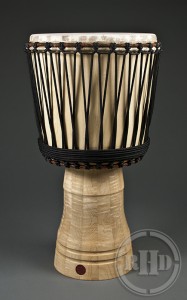
standing you might want a slightly lighter drum. Or a very light drum. It depends on how your body handles weight on your shoulders or hips. How strong you are and how good your back is as well.
The weight on most quality professional level djembes varies from 16lbs to as much as 26 lbs as more. In my experience and opinion it is very hard to find a drum under 18lbs that sounds as good as heavier drums. With thicker heavier wood you generally get more resonation, more fuller sound.
Again this is my opinion and experience and yours or your friends my vary but keep this in mind when shopping.
Wula drums, lists all the weights of their drums on their website which is really nice! remember that a rubber bottom (often optional) will protect your floor and your drum but also ads wait as do other accessories and options.
If you only play sitting then you may opt for a heavier drum. But again please consider the weight carefully and don’t get a drum too heavy or you won’t want to take it out of the house!

Occasionally, you can get lucky and find a light drum that sounds great. If you do, grab it!
As far as size goes, the smaller drums tend to be higher in pitch and more solo oriented. Therefore much less practical or useful as a larger drum. I always recommend medium sized drums.
For me anything from 13″-14″ is good. Keep in mind that every 1/4″ is huge on a drum. It does not sound like a lot here but in actuality it is. The sound and size of the drum does indeed change even with a seemingly small increase or decrease in size and shape.
If you need a recommendation then you are not ready for a strictly (small) solo drum. That is for the elite crowd. That is to say the professional soloists who do not play accompaniment anymore and just solo’s all the time. However, if you are a traveler maybe that is all you can handle (size wise). for me, when I travel I want a small light drum.
There are 3 basic types of skin available now. Goat, Cow (split cow/calf and thin cow) and recently mule skin ( I have only seen the mule from Manito Percussion). You will have to listen to each one to see what is right for you. The mule is a cross between the goat and cow.
My preference for sound is goat skin which is medium thick. However, goat pops the fastest and does not last as long as cow products and mule. Also you don’t have to tune cow and mule as frequently and they are not as subject to loosing tuning from weather conditions. All skins need to be tuned in time and all skins pop in time no matter who you get a drum from. If you take care of your drum and treat it properly you will get much longer life out of it. However, popping is the nature of the beast.
The problem with cow skin is that it is more dense, thicker and harder on your hands. It has become very popular in recent years because of the facts I just mentioned and it also sounds great. However, if your hands are not like brick buyer beware. for most of us it takes a toll on our body.
Because there are so many choices for drums we are going to narrow our search down to the best drums, or the best style drums that I have found in my personal experience playing and being in the drum community for many years (over 40).
Some people recommend buying a small drum or an inexpensive drum to start. I am not going to go there. This is not what this article is about. If this is your goal this is the wrong article for you.
We are going to concern ourselves with professional level djembe drums (since the name of this article is “The Best Djembes”) made from trees or logs, vs drums made from staves or pieces of wood glued together.
I don’t recommend stave drums, that is to say drums made from pieces of wood glued together. I have not heard one sound as good as the real thing.
Those of us who have played for a while disagree on many things but one thing we almost all agree on is that drums from all one log are better then those glued together (staves, like a conga drum). The magic of the solid shell cannot be replicated by pieces of wood glued together.
I have never played a stave djembe that is professional level or sounds anywhere near that of a solid shell djembe. This includes Meinl, LP, Gon Bops, Moperc, etc., etc. I can make them sound pretty good with the right skin on them but basically they don’t sound or feel as good in my experience.
Some of them sound good in their own individual, unique way and I like them as they are super lightweight and easy to tune, just not my cup of tea in terms of sound quality, look and feel. If you want a loud drum for a drum circle this might be good for you however.
But who knows, if someone makes one that sounds as good as a solid shell drum I will play it and post it here as well! I played 2 fiberglass djembes with goat and cow skin that sounded very good. Almost as good as wood recently .Everything is changing and there are great craftspeople out there. And that is what this is all about. Great workmanship, solid quality and great sound!
Unlike conga drums each and every djembe is vastly different from each other even if it is a model that is copied by the same drum
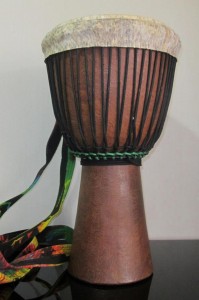
carver or drum company. This is because most popular djembes drums are individually hand crafted from a single log, and because every tree is different, so is the wood which effects the sound.
Also the skins on djembes can vary widely and make a huge difference in sound compared to that of the buffalo skins used on popular mass market conga drums such as those made in Thailand.
Because of this, I can not say that one actual djembe is better then another djembe because there is so much variance from drum to drum. And players look for different sounds.
However, I can say that certain companies such as Wula drum in New York have a reputation for high quality and constantly consistent great drums.
Because they have been working with the same carvers and crafts people for so long in Guinea they have been able to refine their products over the years and achieve a level of professional quality and sound that no one else can simply match. What I love is that when i play one of their drums it sounds very similar to their other drums. They have their own special unique wula drum sound that their drum makers are able to achieve.
So they can say confidently that when you buy a Wula Drum, you know you are going to get that particular, professional Wula drum/Guine djembe drum sound.
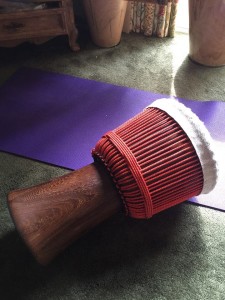
As I previously stated the types of wood used varies, the skins vary and so does the shape of the drum. So sound can vary from drum to drum.
These factors can and will effect the sound even on two drums that look exactly a like made by the same drum carver or company.
So no two djembe drums are the same are even close whereas with congas the drums can be very similar.
I often have drums made from the same log, similar skins and rope, similar weight and sometimes the sound varies. Its important to her sound demos of the drum before you but it if you are ordering on line as well as great photos.
The drum companies and products I am going to list below are drums that i have had some contact or experience with over the years. Hopefully they are
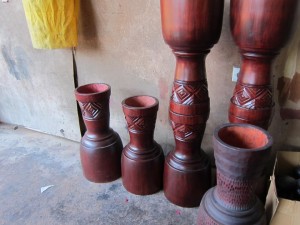
models that I have had constant, positive direct experience with and have played and seen the drums from.
I will also list some of the others that I have gotten very good reports about.
I can not list all the drum companies out there because there are so many. And these are basically companies dealing in or with the USA with one exception.
So I do apologize in advance if your company or your friends company is not here. You can always write in and give me your feedback about your drum and drum company as well. Send photos, too!
There are many small importers or individuals selling fine imported drums as well. As I mentioned too many for me to list.
I will list the drums and companies in this article by approximate price range. Prices always varies as the drums do and various options can drive the price up such as rubber bottoms, inlays and other add ons.
Again these are only my suggestions and in no way do I mean to say these are the only choices out there on the djembe drum market or even the best choices, they are my favorite choices and what I recommend to people who ask me.
I generally suggest to buy the best drum you can afford with the concept of keeping it as long as you can. I am not a believer in entry level or budget drums be it djembes or congas.
When you are buying a djembe you are paying for the wood quality, the skin, the rope quality and the
rigging, or the “set up”, how the drum was put together, laced and pulled. There is a lot of time spent learning to put drums together. I can not emphasize this enough. The art of lacing and mounting is just that, an art form.
There is no substitute for experience, knowledge and knowhow. This is what you are paying for when you buy a professional level djembe.
You are also paying for carvings (if you have them on the drum) and extras such as a rubber tire bottom or rubber pad glued to the bottom or even metal inlay work.
Other extras include ‘Cesse’, the 3 or 4 metal decorative fins many djembe folas use and rubber bands to hold them on, djembe straps and so on.
There are different styles of skinning such as the flap over which overs the outside top ring, the cut off style and other finishes. There are also two and three ring clamping systems.
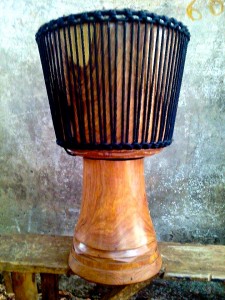
These are all personal preferences and no one can really say which style is better or not. It is really personal preference. I love the flap over style maybe some other people do not. These points can be and are argued about regularly elsewhere.
To me the difference in the most expensive drums and the lesser expensive drums of similar quality is the fit and finish, the rope quality, the skin quality, the add ons and most of all the wood and carvings. The shape, size and weight all play an important role as we have seen as well. The inside of the drum and attention to detail are also factors.
I love the latest carvings i have seen on many of todays popular drums however i personally am completely fine with no decorative carvings. That is just a personal preference as carvings have nothing to do with sound and sound is what i am all about.
Please keep in mind in my opinion it is not how pretty a drum looks or where it is from. It is all about the sound and how comfortable the drum is to play and also to wear if you like to play standing up.
Some people prefer drums from Africa for a variety of reasons. I am not here to argue or discuss those points, there has been much written about this elsewhere already. I have drums made completely in the USA and other countries which are just as nice as my African drums.
I am not for or against drums coming from any particular place. I have been playing great drums made in India, Thailand, Bali and Africa. And I can honestly say they are constantly improving. Soon, as drum makers improve their techniques and continue to learn and grow in their art forms, it will all be very similar quality. There is no way around it and this is the way of the world. When Yamaha first came out making pianos people laughed at them and now they are some of the finest pianos in the world.

Most of the companies mentioned that I know of are trying to use wood from renewable sources, places where trees are being replanted and regrown as well. This is happening more and more and continues to be an urgent issue.
When I look on line, on eBay and on Craigslist I always see listing for professional djembes and they are almost never professional djembes. They are usually awful drums.
Please be careful of these drums. eBay is another place where i very rarely see any decent djembes. Everyone is saying “professional” yet they are not! Not even close. Please do your research and homework before buying.
This is not a djembe buying guide per se, just my choices of drums from the following companies. As usual please click on anything highlighted in brown to be taken directly to that persons or companies website or address.
The following is an updated list and report of drum companies in no particular order. I do have a new article written on this website where I pick the best drums.
Koma Drum
by Tom Kondas
Tom is one of the oldest guys in the djembe business and responsible for many of the updates and positive changes in the djembe and West African drumming business. Koma Drum is a partnership between the exceptionally talented carver Mohamed Kaleb Sylla, 25-year-veteran drum maker Tom Kondas, and some of the most talented artists in West Africa. They are experienced carvers and builders, dedicated advancing the art of drum making, and to improving the conditions of African artists. Over the years, their work and their innovations have set a new standard of quality, and with their new venture – Koma Drum – they continue to take the art of the djembe to the next level.
Djembe Life Drum
by David Joseph Hernandez
Djembe Life is the evolution of my almost four decades long love affair with djembe. David purchased his first drum from the late great Paulo Mattioli, in a San Diego yoga studio in the early 90s. At that time there were almost zero shops to take your drum to be fixed. Learning how to skin and tune your djembe was essential. Over the next couple of decades he found himself becoming more and more intrigued with learning what makes these drums sound so absolutely amazing. Fast forward to more recent history and he began building for friends. Then after much consideration, he decided to jump in, both hands, and do this full time.
Truly every drum has unique qualities that provide the sound you hear. It is exciting EVERY time a drum gets completed and she sounds off for the first time. The work ethic is simple. Make each drum sound as good as it can. Sound is David’s #1 focus. If that’s not right, nothing else is. Nothing quite like this Djembe Life.
Wula Drum
by Michael Markus with M’Bemba Bangoura
They are consistent in both sound and quality at every price point. They have some of the most well made drums. You can count on them for sound and you can count on them to back up their product as well.
They are designed by drummers – Wula Drum

Most people will agree that for the top dollar, Wula drums has some of the best sounding and arguably some of the most beautiful drums on the market today, with the most exquisite, beautiful and intricate wood work and wood carvings. Real art pieces that sound great.
Drumskull Drums
by Matt Hardwick
Drumskull Drums has many very fine choices in Kahdi, Linge (Lenke) and other traditional djembe woods. When I see a Drumskull drum, (and I see many) they always have consistent quality, sound and beauty.
Matt is not only an excellent craftsman he is a great player as well and he really knows how to go for

and get the right sound out of his drums. Furthermore Matt has been doing this a long , long time now and really has the art perfected.
He is also putting some killer rubber bottom rings on the drum which really enhance the look, save the bottom of the the drum and also any floor you may play on. They are glued on so no nails go into the wood. This is one of my favorite advancements Matt has come up with!
Furthermore, he has perfected the art of the flap over skin and what more can I say except for any djembe needs you have from spare parts, cases to the whole drum, these are the “go to guys”.
Marcus and Gemma Brown.

Update: Now in the UK!
Marcus formed Wooden Roots in 2007 whilst living in a tiny 600 sq feet apartment in Woodland Hills, CA. It was very much a low key affair as he and his wife worked their corporate jobs by day, however on weekends it gave Marcus the creative outlet to do what he enjoyed – building, selling and teaching djembe to thelocal community. The turning point for them came when they bought their first house and got married 2009/10. Their house afforded them more space to grow the business and operate from and they held classes and workshops in their living room. We built the very first Wooden Roots workshop in our back yard!
Another great company is Motherland Percussion. Motherland has been in business for over 35 years.
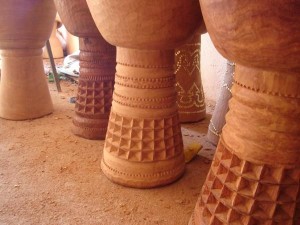
Motherland Music and Drums is the central point for drumming in Los Angeles.. They are big in the community there.
They have a solid reputation and are a very reliable company and easy to deal with as well.
They have a wonderful website and all kinds of drums from Africa including congas and bata, too. I have not ordered from them but all the reports from buyers I have talked to have been very positive. I would stay away from the shells from Ghana. I have played some excellent djembes in Iroko wood with goat skin flap over skin job and rubber bottom that was very nice indeed.
Although it is African they are not quite on par yet with the other drums from Guinee and Mali. However, they may soon be.
African rhythm Traders offers a solid djembe offering from Guinea.
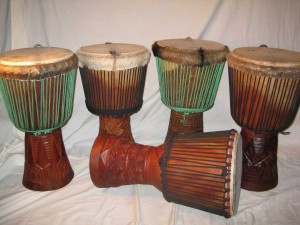
They also have flapover skin job also known as a “cuff”.. they look great, sound good and are made of quality materials.
They have been around for a while and there are never any worries dealing with them. A very straight ahead company and product.
Djembe Drums & Skins, Inc – Djembe Drums & Skins
This was Shorty Palmer’s company for many years, now under new ownership.
Anyone involved for any time in the djembe drum world knows of Shorty Palmer and this company.
They also offers “seconds”, slightly out of shape or very slighty damaged drums at a significant savings. If you are on a very strict budget you will want to check them out.
Their drums, mostly from the Ivory Coast may not be as beautiful as the pricier models of some of the other makers on this list, but with a little bit of finish work their drums can sound as good.
If your drum has to be from Africa, and you want the least expensive best sounding drum you can get for the least amount of money, they are a great choices and offer a wide variety of drums from all over west Africa as well as drum making supplies, too. They have build your own drum kits as well.
I have played several of his drums and they are always consistently great sounding. A very solid resource for anything in the djembe world and another great all around go to guy as well.
e with djembes, the skins do not last as long and if the skin pops you are looking at an expensive replacement.
You may want to look at a good friends used djembe or possibly look on Craigslist for possible deals although they are rare to find in this price range but who knows? You could get lucky. I found a reasonably priced djembe my teacher Bolokada Conde hand pulls and riggs his own drums and shells originating from Guinea, West Africa.
Someone had won at an auction and had not played it for a few years. The skin needed replacing but other then that the drum was in perfect condition. Remember to replace a skin if you do not do it yourself is going to be in or over $150 U.S.!
SOME OTHER VERY INTERESTING AND SOLID OPTIONS
Wassoulou Percussions – Djembés et Instruments d’Afrique de l’ouest
Wassolou Percusion
Michael Tivier has some beautiful drums from Mali. His site is in French but you can see all of his very interesting line of African instruments there. He lives in Mali and is very dedicated to bringing fourth a very high quality, beautiful and all around great product.
James Mack a percussionist and performer from Cirque du Soleil also has some nice and interesting drums you can check out more about him and his drum offerings.
Nate Vellinga comes highly recommended from some good drum buddies of mine. A very knowledgable drummer and drum rigger.
I looked at his site and talked with him extensively about his drums. He has some beauties and really knows his stuff. He has travels to and studied in Mali as well and is a former student of Abdul Doumbia now in Colorado. He is also a very good drummer.
African Djembe, Ashiko, Custom Hand Drum | Rhythm House Drums
Another interesting djembe and drum company is Rhythm House drums. I do not have any experience with them but they sure look great and worth checking out for sure. Some of their carved drums look right up there at the top of the line. Check out these drums in the photos! Pretty amazing looking drums for sure!
There are many types of wood used for making djembes. My favorite are Khadi and Lngue. Below are a list of other woods.
khadi (Hare, Gueni, Kari, Bala Wood)
guele (Iron Wood, gele)
lingue (lenke, lenge)
duki (dugara, dougara)
acajou (Djala, Diala, Bois Rouge)
iroko (african oak, sine)
melina (whitewood, bois blanc)

